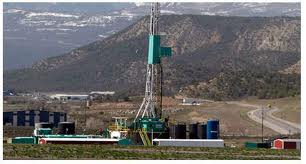PART 2. NATIONAL PUBLIC RADIO SERIES ON SHALE GAS DRILLING & FRACKING.
Here is a condensed version of the NPR report:
Living in the middle of a natural gas boom can be pretty unsettling. The area around the town of Silt, Colo., used to be the kind of sleepy rural place where the tweet of birds was the most you would hear. Now it’s hard to make out the birds because of the rumbling of natural gas drilling rigs. The land here is steep cliffs and valleys. But bare splotches of earth called well pads are all over the place.
Nearly a decade ago, Garfield County in Colorado started trying to tackle that question, and was chugging ahead of the whole country in pursuit of scientific truth. Local politician Tresi Houpt was the engine pushing that effort.
As she started to campaign to be a Garfield County commissioner, she came down from her home on a ski mountain to meet people in ranches, rural neighborhoods with the big blue skies and clear starry nights. She couldn’t believe what she saw: drill rigs right outside homes, armadas of diesel-spewing trucks, fumes wafting from equipment called compressors and condensate tanks. In Colorado, you can have a drill rig 150 feet from homes.
In 2002, Houpt won her election. And one of the first things she wanted to know was: Did scientists have any answers for what was in the air near wells?
Houpt and the other commissioners agreed to start spending some of the county’s gas royalties to try to get answers. They brought in Jim Rada to create an environmental health office. “There are pipelines, there are storage yards, compressor stations, gas plants,” he says, as we drive along in his hybrid SUV past thousands of sources of air pollution. Diesel exhaust spews from trucks and drilling rigs. Methane, chemicals that make ozone, and fumes that contain cancer-causing benzene leak from wells and storage tanks.
Rada figured it would be impossible to track all this pollution, so back in 2005, he set up monitors in towns where most of the people lived. Gadgets on the roof monitor soot, smog and volatile organic compounds, known as VOCs. Years of data from these and other monitors around the county have shown that the industry is putting a lot more chemicals into the air that create smog. But levels of smog and other air pollutants still meet EPA health standards.
In 2008, he got permission from companies to put air sampling canisters around eight wells that were being drilled. Then, for 24 hours, those canisters captured the chemicals that were coming off the wells. He found very large amounts of chemicals. Some of them, like benzene, can cause cancer. Others, like xylenes, can irritate eyes and lungs.
Rada’s air monitoring work was rare enough that it was getting attention at some higher levels. The Centers for Disease Control and Prevention and Colorado’s state public health agency were analyzing his data for answers.
But they didn’t really find any. For instance, Rada’s eight-well test was just a pilot study. He didn’t test the air long enough or at enough places to know how much chemicals people were really being exposed to.
At that point, Rada says the job got too big for him. This was 2009. Nearly 3,000 wells had gone in the year before. The county needed help. And its next move turned out to have some pretty painful consequences.
Rada called in the Colorado School of Public Health to examine whether lots of new drilling within a neighborhood might hurt people’s health. To make their conclusions, the researchers were supposed to use existing studies, such as the county’s monitoring data, and whatever other science they could find. A draft assessment by the school predicted small increases in risks of cancer, headaches and lung ailments.
People who live near gas wells held up the researchers’ work to attack the industry in lawsuits and in the media. And gas companies fought back. “Both sides were fighting,” recalls John Martin, a longtime county commissioner. “They wanted to use this document in both arguments — that it didn’t hurt anything and that it killed everyone.”
In May of last year, the commissioners gathered for a meeting and voted to end a contract with the Colorado School of Public Health. Tresi Houpt, who had lost her re-election and wasn’t part of the vote, saw her years of work unraveling. All that momentum the county had built up came to a screeching halt.
So, 10 years have passed since Houpt first drove around her county, hearing complaints about air pollution and the gas industry. And Garfield County’s 800 gas wells have grown to more than 8,000. People who live near wells — whether they’re in Texas, Pennsylvania or Utah — still don’t know what they’re breathing.
Houpt believes Garfield County’s saga shows how politics, industry pressure, technical challenges and the slow pace of science have blocked the search for answers — not just for her community, but for the whole country.
See also this posting in FrackCheckWV.

